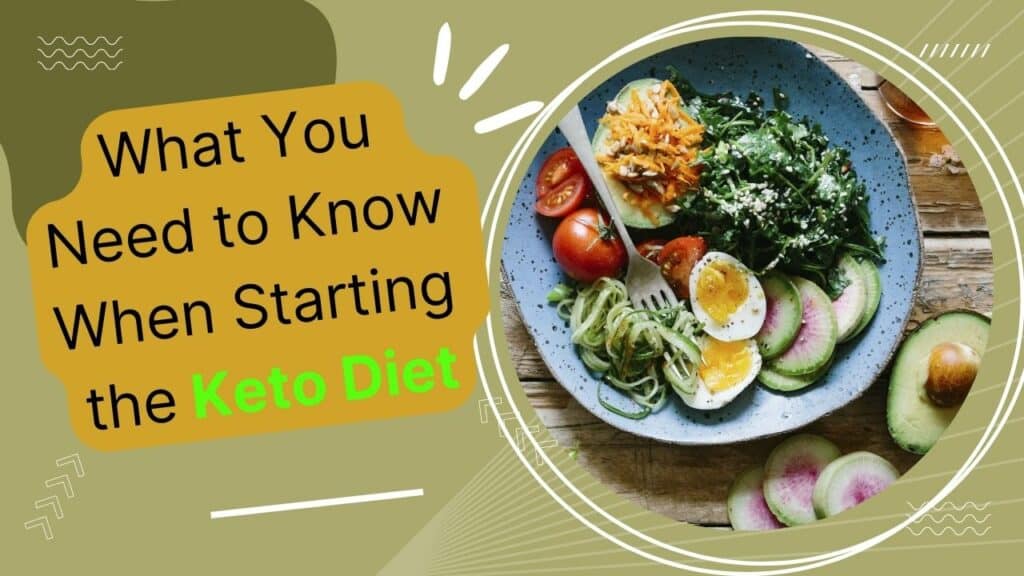What You Need to Know When Starting the Keto Diet.

Disclosure: You should be aware that some of the links in this article may be affiliate links, which means that if you decide to buy something through one of these links, I may receive a commission, which does not increase the cost to you. This site does not provide financial or medical advice and is just for entertainment purposes. In our privacy policy, you may see our affiliate disclosure.
The ketogenic diet is an extremely low-carb, high-fat diet. This means that you’ll need to dramatically lower your carb intake while increasing your fat intake.
The objective is to put the body into a metabolic condition known as ketosis, which assists in the promotion of weight loss (and sometimes mental clarity). A keto diet can be begun by cutting out all carbs and consuming more healthy fats like avocado, nuts, and seeds.
This post will walk you through how to begin the keto diet, what you absolutely need to know, and the measures you should take after beginning this diet.
What is the Keto Diet?
The Keto Diet is a type of diet that encourages the body to burn fat instead of carbohydrates by restricting carbohydrates and increasing the amount of fat consumed.
It was first created in the 1920s as a therapy for epilepsy in children and was first used in that capacity. The ketogenic diet is comparable to the Atkins diet, but it takes a more moderate approach to the amount of fat and protein that one consumes.
The ketogenic diet is an efficient means of achieving weight loss. Studies have shown that following a ketogenic diet, which is characterized by meals that are high in fat, moderate in protein, and low in carbohydrates, can result in significant weight loss in a relatively short period of time.
The ketogenic diet speeds up the metabolism by shifting the body’s focus from carbohydrate consumption to fat burning. It does this by forcing the body to use its own fat as a source of fuel. This indicates that you will burn calories even while you are doing absolutely nothing!
Table of Contents

FREE
Weight Loss eBook
Discover How To Get Rid of Stubborn Belly Fat the Easy Way and Forever.
How does the keto diet work?
The keto diet is effective because it calls for a significant reduction in the number of carbohydrates consumed while emphasizing the consumption of fat instead.
Your body will enter a metabolic state known as ketosis as a result of this reduction in carbs, which is a state in which fat, both from your diet and from your body, is used for energy.
When you eat a diet that is low in carbohydrates, your body is forced to look for other sources of fuel to keep itself going. Typically, this is glucose derived from the sugar in your meals or glycogen that has been stored in your liver and muscles.
When we consume carbohydrates or sugar, our bodies turn that food into glucose, which is then used as a source of energy for us. After then, glucose will make its way through the circulatory system until it reaches the cells, where it will be used as fuel.
However, if there is no sugar available from food or drinks, your liver will convert some amino acids into glucose so that they can be utilized as an alternative source of energy. This happens when there is a shortage of sugar. In this circumstance, we refer to them as ketone bodies.
When we consume foods that contain carbohydrates, such as bread or pasta, our bodies convert those carbohydrates into glucose, which is then stored as glycogen in our livers. Bread and pasta are two examples of foods that contain carbohydrates.
When you begin an exercise routine and deplete all of the glycogen stores in your body, your liver will begin the process of turning fat into ketones so that they can be used as a source of fuel. The term “ketosis” refers to this metabolic process.
What to expect on the keto diet.
The keto diet has been around for years and is credited with helping people lose weight and improve their health, but there is still a lot of confusion about what it entails.
The keto diet can result in many different benefits, such as improved blood sugar levels, lower cholesterol levels, increased energy levels, mental clarity, and a reduction in inflammation and acne breakouts.
The ketogenic diet is a low-carbohydrate, high-fat diet that calls for substituting a significant portion of one’s usual carbohydrate consumption with fat intake instead. This change in the consumption of macronutrients can bring about a reduction in both blood sugar and insulin levels, which in turn may result in weight loss.
In addition, the keto diet may increase satiety while simultaneously reducing feelings of hunger, making it a potent tool for weight loss.
However, this type of diet plan does come with some risks too, including dehydration, constipation, fatigue, cramps, headaches, heartburn, nausea, vomiting, diarrhea, nutrient deficiencies (such as calcium), and even kidney stones.
The first tip to getting your body into a ketosis state is by following a low-carb or no-carbohydrate diet. This will force your liver to convert fat reserves into fatty acids, which are then used for fuel.
The second way to enter ketosis is thru fasting. Fasting can be done on any level, from just skipping breakfast together to going without food for days at a time.
Why do people choose the keto diet?
People could decide to follow a ketogenic diet for a number of different reasons. These reasons are listed below. For some people, it may be a means of controlling a medical condition such as diabetes or helping them to achieve their weight loss goals. Others may discover that following the ketogenic diet allows them to have increased mental and physical clarity.
A challenge of any kind can be fun for some people, and adhering to a rigorous diet plan can be no exception.
For whatever reason, following a ketogenic diet can be an excellent way to make improvements to one’s health and overall well-being.
The ketogenic diet is one that is low in carbohydrates, high in fat, and moderate in protein intake. This movement has picked up steam as a result of the proliferation of social media and the endorsement of these lifestyle shifts by celebrities.
Despite the fact that the ketogenic diet is not primarily focused on weight loss, the term “keto” has become synonymous with weight loss.
To begin, a person who follows a ketogenic diet might choose from one of three distinct variations. The ketogenic diet is becoming increasingly popular as research demonstrates that it can result in both weight loss and improvements in mental health.
Diets based on the ketogenic model are gaining popularity all over the world. They are most well-known for their application in the treatment of epilepsy and in the reduction of obesity-related problems.
Beginning with a meal that is very low in carbohydrates and quite restrictive, the Ketogenic Diet compels your body to draw on its stored fat for energy while simultaneously supplementing it with ketones.
When following the ketogenic diet, it is essential to limit daily carbohydrate consumption to less than 20 grams.
If you are following a ketogenic diet, your end objective is to enter a state known as ketosis. This takes place when your body converts fat stores into ketones, which it then uses for energy rather than glucose.
When you consume a diet that is high in fat and low in carbohydrates, such as the ketogenic diet, you will find that you lose more weight and have improvements in your health markers.
If you deprive your body of carbohydrates, it will switch to using fat for fuel and will begin creating ketones, which can be detected in the blood or urine.
Best way to start the keto diet.
When it comes to starting the keto diet, there is no one-size-fits-all answer. However, there are some general guidelines that can help make the transition to a keto diet easier and more successful. Here are some tips for starting the keto diet:
- Get rid of all high-carb foods from your pantry and fridge. This includes bread, pasta, rice, cereal, crackers, chips, fruit, juice, milk, sweets, etc. Replace them with low-carb alternatives like vegetables, meat, fish, eggs, cheese, nuts, seeds, and healthy oils.
- Calculate your ideal daily carb intake. This will vary depending on factors like your activity level and weight loss goals. A good starting point is 20-50 grams of carbs per day.
- Meals on the ketogenic diet should center around sources of protein like meat, poultry, fish, and eggs. Include a substantial number of salads, leafy greens, and vegetables that are low in starch.
If necessary, extra calories can be added to olive oil and other sources of fat. Steer clear of foods that are high in sugar and carbohydrates. Consume some water, herbal tea, or coffee.
If you are new to the keto diet, it is important to take things slowly at first. Start by cutting out processed foods and refined carbohydrates from your diet, and focus on eating fresh, whole foods.
Once you have made these changes, you can begin to experiment with different ways of incorporating healthy fats into your meals.
It is also important to make sure that you are getting enough electrolytes, as this can help reduce the risk of side effects such as headaches and muscle cramps.
What kind of food do you consume?
When first beginning a ketogenic diet, the vast majority of people start by removing all starchy carbohydrates from their diet.
When beginning the ketogenic diet, there are a few things that you should keep in mind.
To begin with, it is essential to have a solid understanding of the fundamentals of the diet and how it operates.
Second, you must make certain that you are consuming an adequate amount of calories and nutrients.
Third, you have to be ready for the possibility of experiencing some adverse effects. In the fourth place, you should devise a strategy for how you will continue to follow the diet in the long run.
Stay away from bread (including wheat), pasta, grains, potatoes, corn, rice, and other “root” vegetables like potatoes.
Instead, they should focus on eating plenty of leafy greens, noni fruit, berries, nuts, seeds, avocados, eggs, fish, meats, poultry, tofu, beans, lentils, broccoli, cauliflower, cabbage, cucumber, zucchini, mushrooms, tomatoes, asparagus, bell peppers, onions, garlic, ginger, cinnamon, turmeric, cayenne pepper, basil, oregano, thyme, rosemary, and dill, marjoram, sage, parsley, chives, kefir, kimchi, sauerkraut, pickles, mustard, and other foods that fall into these categories.
Possible side effects of the keto diet.
The keto diet has been shown to have a variety of potential side effects, including weight loss, increased energy levels, and improved mental clarity. However, it is important to note that these potential side effects are based on anecdotal evidence and more research is needed to confirm them.
Some possible side effects of the keto diet include:
1) decreased blood sugar levels, which can lead to hypoglycemia;
2) increased risk of dehydration;
3) electrolyte imbalance, which can lead to muscle cramps and weakness;
4) constipation;
5) kidney stones; and
6) slowed metabolism.
Keto Flu
Another common side effect is the “keto flu” which is a phenomenon that affects some people when they first start a keto diet. It usually occurs within the first few days of changing their intake, and symptoms can include dizziness, headaches, nausea, and fatigue.
Keto flu can be a common side effect of starting the keto diet. It is a result of the body’s going thru a process called keto-adaptation. The flu-like symptoms usually go away after a few days as your body becomes adjusted to a new way of eating.
If you experience any of these symptoms while on a ketogenic diet, it’s important to talk with your doctor about what may be causing them so you don’t have to worry about missing out on this healthy lifestyle change!
Summary
The ketogenic diet is one that is heavy in fat and has very little amount of carbohydrates. This suggests that you will need to considerably cut down on the number of carbohydrates that you consume while at the same time increasing the amount of fat that you ingest.
The objective is to bring about in the body a metabolic state known as ketosis, which plays a significant part in the process of facilitating weight loss as well as other health benefits (and sometimes mental clarity).
To begin following a ketogenic diet, it is necessary to cut out all sources of carbohydrates and significantly increase the consumption of foods that are rich in healthy fats. Some examples of such foods include avocados, almonds, and seeds.

FREE
Weight Loss eBook
Discover How To Get Rid of Stubborn Belly Fat the Easy Way and Forever.
Disclosure: You should be aware that some of the links in this article may be affiliate links, which means that if you decide to buy something through one of these links, I may receive a commission, which does not increase the cost to you. This site does not provide financial or medical advice and is just for entertainment purposes. In our privacy policy, you may see our affiliate disclosure..




